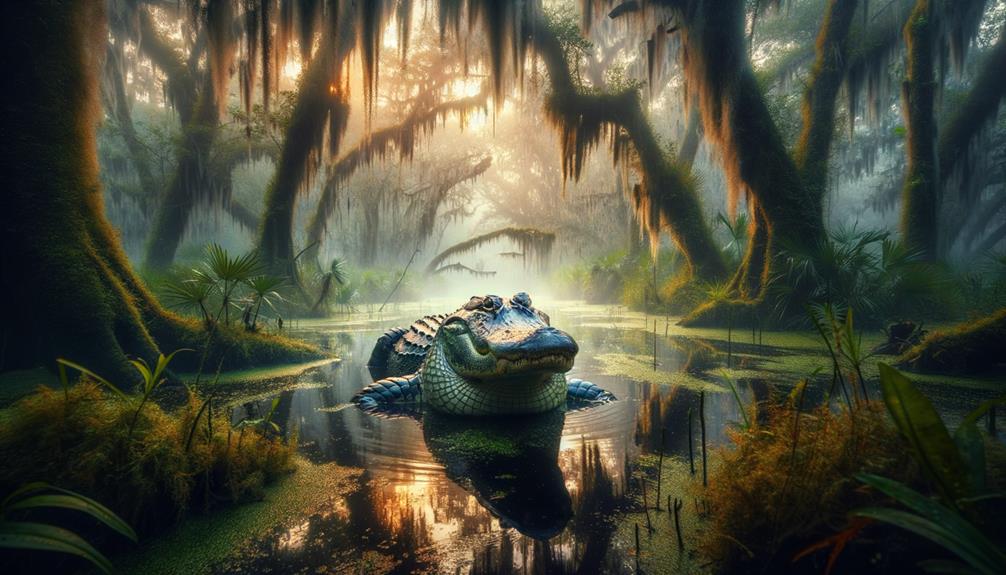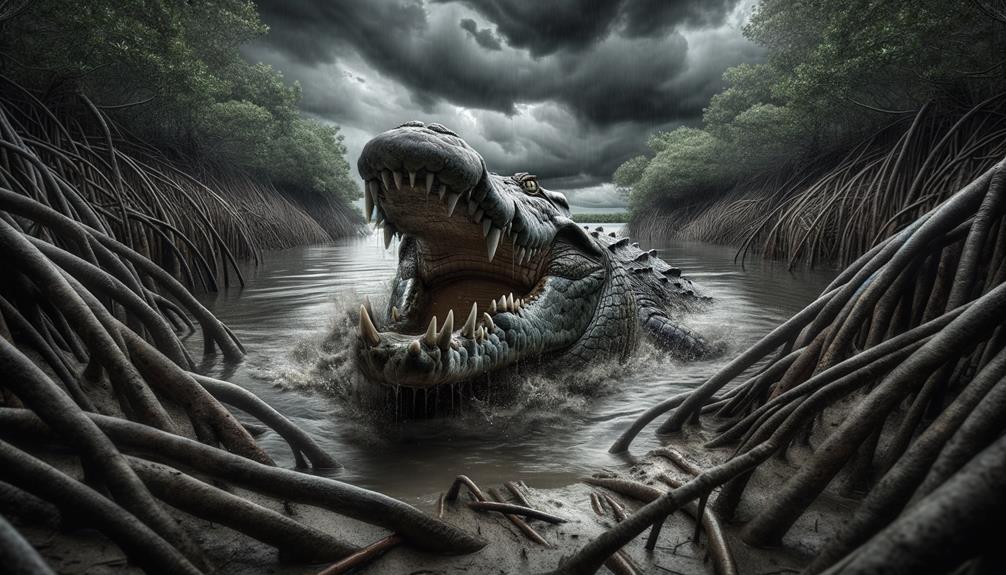Caimans belong to the Caimaninae subfamily within the Alligatoridae family and are native to Central and South America. These crocodilians have robust, scaly skin and distinct bony ridges between their eyes. In terms of size, the black caiman can reach lengths of over 4 meters, while the dwarf caiman stays under 1.5 meters. Caimans inhabit varied aquatic environments, from freshwater rivers to brackish swamps, and have a diverse diet that includes fish, birds, and mammals. They reach sexual maturity at around 6-8 years and build nests for their eggs. As you learn more about these remarkable reptiles, you'll uncover fascinating details about their behaviors and habitats.
Key Takeaways
Caimans are a type of crocodilian that belongs to the Caimaninae subfamily within the Alligatoridae family. You can find them in various aquatic environments across Central and South America, including rivers, wetlands, and lakes. The largest species, the black caiman, can reach lengths of over 4 meters. These carnivores have a diverse diet that includes fish, birds, and mammals, and they use stealthy ambush tactics to catch their prey. Female caimans build nest mounds and lay 10-50 eggs, and the young stay together in groups for up to 18 months after hatching.
Species and Classification
Caimans, which belong to the subfamily Caimaninae within the Alligatoridae family, comprise several species including the spectacled caiman, yacare caiman, and broad-snouted caiman, as well as the black caiman and the smallest members of the Paleosuchus genus. Each species has distinct characteristics and adaptations that fit their specific niches within Central and South American freshwater environments.
The spectacled caiman (Caiman crocodilus) is one of the most widespread and recognized species, known for the bony ridge between its eyes that resembles spectacles. The yacare caiman (Caiman yacare) and broad-snouted caiman (Caiman latirostris) share the same genus and exhibit distinct ecological behaviors. The black caiman (Melanosuchus niger), the largest species, can exceed 4 meters in length, showcasing its dominance within its habitat.
In contrast, the Paleosuchus genus includes the smallest caimans: the smooth-fronted caiman (Paleosuchus trigonatus) and Cuvier's dwarf caiman (Paleosuchus palpebrosus). These diminutive caimans rarely exceed 1.5 meters, adapting to more secluded environments. Understanding these diverse species within Caimaninae highlights their remarkable adaptability and ecological roles in their natural habitats.
Physical Characteristics
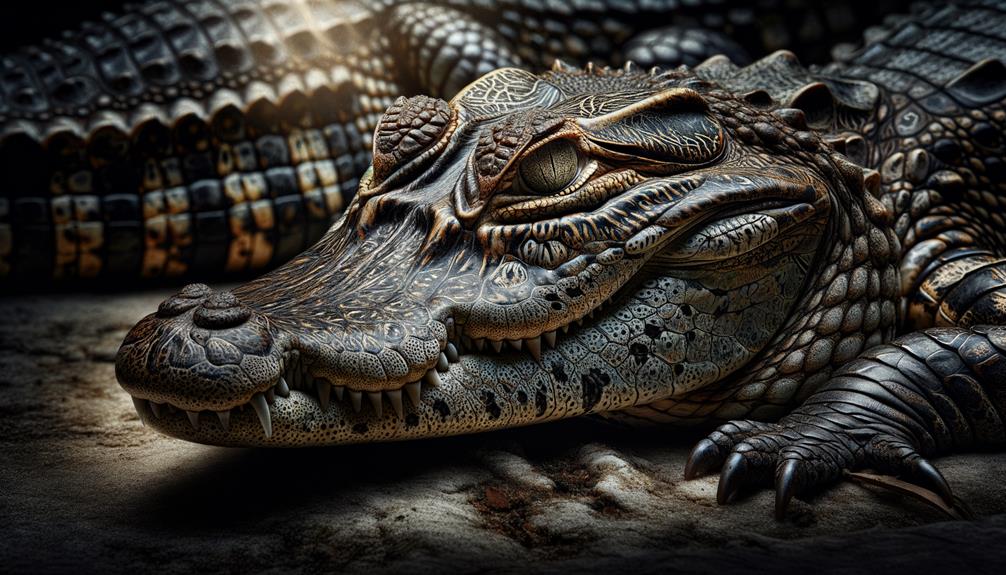
Many caimans have robust, scaly skin and broad snouts, featuring bony ridges between their eyes that contribute to their distinctive appearance. These South American crocodilians, part of the subfamily Caimaninae, show remarkable adaptability to various environments. The spectacled caiman, named for its prominent bony ridge, is the most widespread species in Central and South America.
To better understand their physical characteristics, consider the following:
- Size Variation: Caimans come in all shapes and sizes. The black caiman can reach over 4 meters in length and weigh up to 1,000 kg, while the dwarf caiman is much smaller, usually inhabiting slow-moving rivers and weighing between 6-40 kg.
- Skin Texture: Their scaly skin provides protection and helps them regulate their body temperature. This feature is crucial for surviving different climates and water conditions.
- Snout Shape: The broad snouts of caimans are adapted for a diet consisting mainly of fish and small mammals. The shape and structure of their snouts allow them to capture prey effectively in their aquatic habitats.
Habitat and Distribution
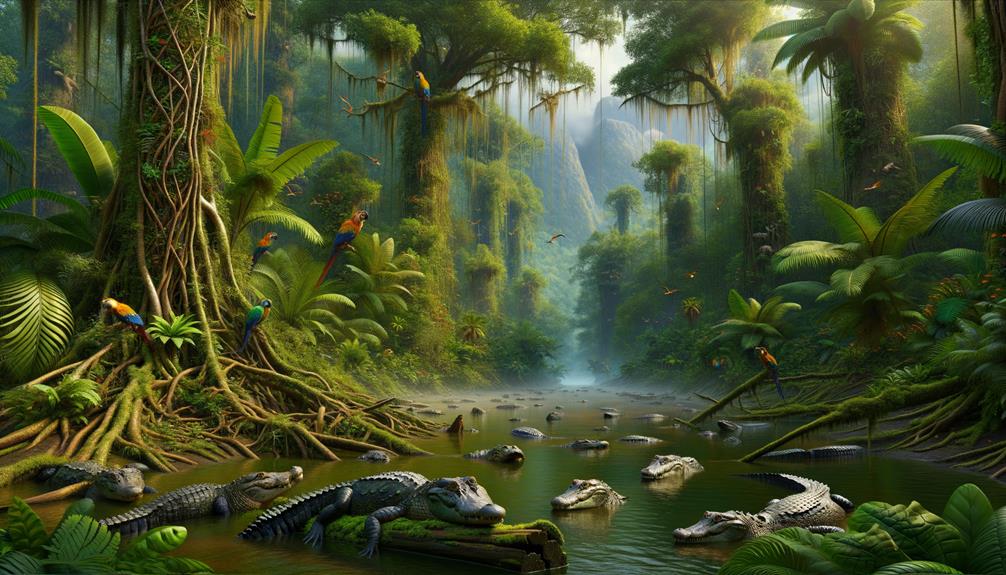
Habitat and Distribution
Caimans' physical attributes provide insight into their ability to thrive in diverse aquatic environments across Central and South America. These resilient reptiles are native to a range of habitats, from marshes and swamps to lakes and mangrove rivers. In Central America, the spectacled caiman can be found from Mexico down to Brazil, showcasing a broad distribution that highlights their adaptability.
In South America, the yacare caiman's habitat is concentrated in the Pantanal, one of the world's largest tropical wetlands, spanning central southern regions. This area provides an ideal environment with its extensive water systems and abundant wildlife. The broad-snouted caiman, on the other hand, occupies central and eastern South America, often residing in major river drainage systems, indicating their preference for stable, flowing waters.
Some species, like the smooth-fronted caiman, have more restricted ranges. They inhabit the fast-flowing rocky streams and rivers of the Amazon basin, demonstrating their adaptability to specific ecological niches. Most caimans prefer low-lying wetland habitats, although they can be found at elevations up to 800 meters. Their widespread distribution across various aquatic environments underscores their ecological versatility and resilience.
Diet and Hunting
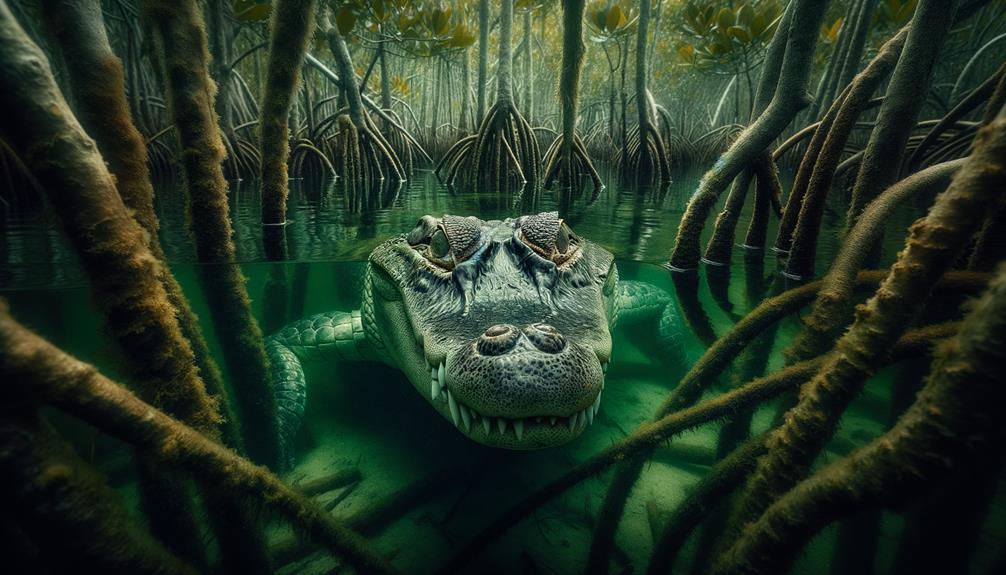
Caimans are skilled predators with a diverse diet that includes fish, birds, and even large mammals like capybaras. They're masters of ambush tactics, using their powerful jaws and sharp teeth to capture and devour unsuspecting prey. Here's a closer look at their feeding habits:
- Ambush Hunting: Caimans lie in wait just below the water's surface, waiting for the perfect moment to strike.
- Diet Variation: Young caimans feed on insects, crustaceans, and small fish, while adults target larger animals.
- Cooperative Hunting: Larger caimans sometimes hunt in groups, tackling bigger prey and sharing the meal with younger individuals.
These adaptable predators aren't picky eaters. Their diet changes with age and size, ensuring they make the most of available resources. Whether stalking or ambushing, caimans showcase remarkable flexibility. Their strong jaws and sharp teeth are perfectly suited for their feeding strategies, making them formidable hunters in South American waters. This combination of tactics and physical adaptations explains their success as apex predators.
Reproduction and Lifespan
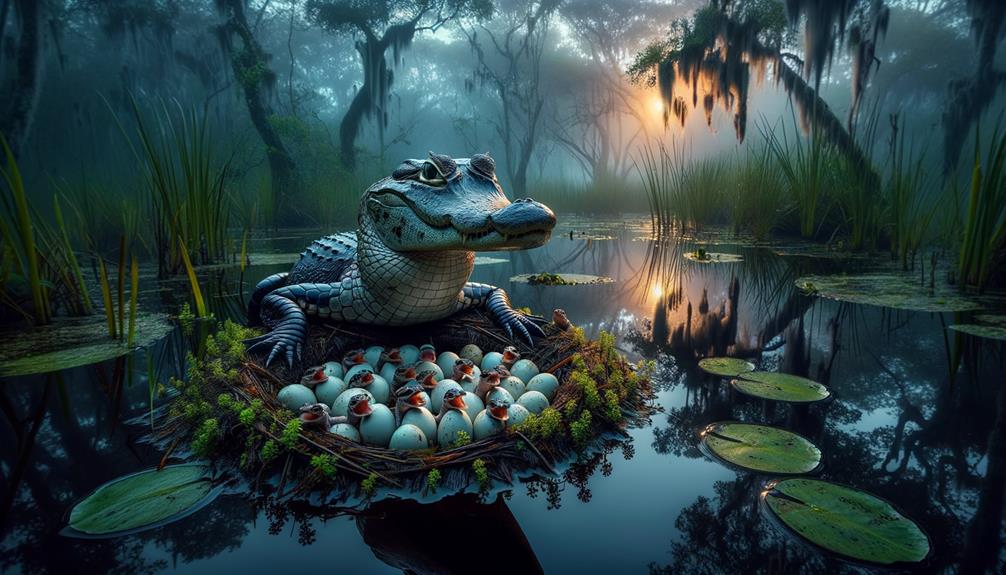
Caimans' reproductive behavior and lifespan are fascinating aspects of their biology. These reptiles reach sexual maturity between 6-8 years old and can live up to 40-50 years in the wild. Female caimans build intricate nest mounds using vegetation and mud, which protect the 10-50 hard-shelled eggs laid within. The incubation period lasts around six weeks, after which hatchlings emerge.
At birth, hatchlings measure approximately 23 cm and can grow to about 60 cm within their first year. These young caimans typically remain in groups for up to 18 months, benefiting from their mother's protection. This period is crucial for their survival, as both nests and hatchlings face significant predation threats from various animals and potential destruction by humans.
The social structure within these groups enhances the young caimans' chances of survival. The mother's vigilance plays a vital role in shielding the hatchlings from predators, ensuring they have a better chance of reaching maturity. Observing these interactions offers a glimpse into the complex life cycle of caimans, highlighting their resilience and adaptability in the wild.
Frequently Asked Questions
Are Caiman Crocodiles Aggressive?
Caimans are generally not aggressive and will only defend themselves if they feel threatened. The smaller species tend to be less aggressive than their larger counterparts. Human attacks by caimans are rare and usually occur when they feel provoked or when their nests are in danger.
Are Caimans Harmless?
Caimans aren't entirely harmless. While they tend to avoid humans, they will defend themselves if they feel threatened. It's crucial to approach them with caution and respect their natural behavior, as attacks, although rare, can occur, mostly involving smaller caimans.
Is a Caiman More Alligator or Crocodile?
I'd say a caiman is more like an alligator. They belong to the same family, Alligatoridae, and share similar physical characteristics, such as broad, rounded snouts. Unlike crocodiles, caimans don't have a prominent fourth tooth when their mouths are closed.
Are Caimans Friendly?
Caimans aren't pets, and they're not meant to be cuddly friends. They're wild animals that belong in their natural habitats, not in our living rooms. While they're fascinating creatures, it's crucial to maintain a safe distance and respect their space. Getting too close can be dangerous, so it's best to appreciate them from afar.


